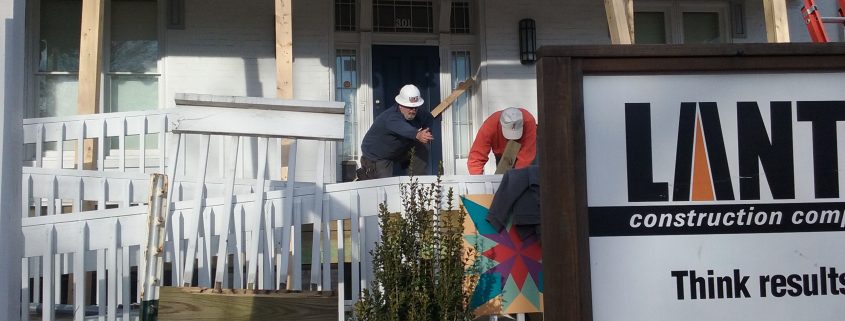An Old House Gets A New Look
RYAN CORNELL Daily News-Record
PUBLICATION: Daily News-Record (Harrisonburg, VA)
SECTION: News
Photo courtesy of Lantz Construction Company
DATE: April 18, 2017
HARRISONBURG — For more than 160 years, the Warren-Sipe House at 301 S. Main St. has served a wide range of purposes.
The house, built in 1855, provided shelter to the two families — the Warrens and the Sipes — that called it home over the years. It weathered the storms known to barrel through the Valley during the spring and fall. And it kept them warm during the colder months.
The building was used as a hospital for wounded soldiers returning from the battlefield during the Civil War. Soldiers such as Joseph Latimer, who at 18 was the youngest artillery battalion commander in the Confederate Army, were treated for their injuries in its rooms. Some of them, including Latimer, died inside the house.
Starting in 1956, the structure housed the city’s Parks and Recreation Department, which hosted dances, classes and after-school programs within its walls. It served as the headquarters for the Harrisonburg-Rockingham Historical Society in 1978.
The modest Greek Revival-style building was even converted into a courthouse while the original was being renovated between 1993 and 1995. A holding cell was installed on the first floor of the house and remains there today.
Through it all, the front porch attached to the historic Warren-Sipe House — the site of the Virginia Quilt Museum since 1995 — has faithfully led family members, soldiers, lawyers, quilters and other visitors through its front door.
But last summer, the porch began to show its age.
The brick pillars supporting the porch leaned away from the house, presenting a safety hazard. The floorboards were in dire need of replacing.
After consulting with experts, including a preservation architect, the museum’s executive director, Kimberly McCray, said the group decided the entire porch needed to be replaced.
“The architect looked at it and said, ‘We definitely need to act,'” McCray recalled. “And so, of course, we just started your basic process of talking to different construction firms.”
Museum staff put out a call for bids on the project and accepted an offer from Broadway-based Lantz Construction Co., which McCray said worked with the museum to keep costs down.
“We’d definitely love to give them big props,” she said.
The museum remained open while one end of the porch was closed to the public, and McCray and others quickly went to work raising funds for a complete reconstruction.
In August, the museum launched its Rocking Chair campaign with a goal to raise $20,000 toward the project.
What it received by October was nearly $10,000 more than the goal.
That total funded about three-quarters of the project. The rest, McCray said, was covered by “hundreds upon hundreds” of volunteer hours spent framing the porch’s decking and taking down the old porch.
“When Lantz saw the framing that our volunteers had done, they were just blown away,” she said. “They said it was better than what they would have expected from volunteers.”
Originally, McCray said, the plan was to replace the floorboard and decking and keep the original railings and columns intact.
“We did not expect the cost to be that much, which is why we only had our goal at $20,000,” she said.
But under closer inspection, it was clear more work needed to be done. And that’s when Lantz and museum staffers realized their problem was a much bigger, and more expensive, one than they had thought.
The porch’s columns, banisters and railings, warped by the ravages of water and time, showed signs of deterioration.
“As soon as Lantz took down the columns — now these are from the 1850s — as soon as they came in … and took the columns out, the older ones basically started to crumble in their hands because there was just so much water damage and rot,” McCray said. “At that point, the cost went way up.”
Adding to costs was the project’s mission of keeping the porch attractive and historically accurate, while complying to code set by the Americans with Disabilities Act.
McCray said work was done to keep the tongue-in-groove-style decking present in the original porch, and to match the old paint color.
“I’ve been told we’re [one of] the only antebellum residence[s] in downtown Harrisonburg,” McCray said, “so keeping that as historically accurate as we could was very important.”
Crews also raised the porch so that it would be level with the museum’s front door, and visitors would no longer need to step up to enter the building.
Work started on the porch in January, with crews adding their finishing touches to the project at the beginning of this week.
McCray credited Ken Reeves, chairman of the museum’s facilities committee, and the many volunteers for the project’s success. She said an official dedication for the new porch is planned for mid-May.
“I think our members know this house is a blessing to us,” she said, “and people really enjoy coming to a historic structure.”
Philip M. Herrington, an assistant professor of history at James Madison University, described the house as “one of the most historically and architecturally significant buildings in the city.”
“To my knowledge there is not another high-style Greek Revival house in Harrisonburg,” he wrote in an email. “Unfortunately a house very similar in size and style to the Warren-Sipe house, the John T. Harris house, which stood on an adjacent lot, was demolished in the 1960s, and such losses only heighten the necessity of preserving the Warren-Sipe house.”
A HOUSE WITH HISTORY
According to the Virginia Quilt Museum, the Warren-Sipe House was first owned by Edward T. Harrison Warren, a direct descendant of Thomas Harrison, the founding father of Harrisonburg.
Warren’s uncle, William Rice, built the house for Warren and his new wife, Virginia Magruder, a brochure about the house’s history says.
The cost of building the house was about $6,000, it says.
Warren, a prominent lawyer in the city before the Civil War, commanded the 10th Virginia Volunteer Infantry as a colonel in the Confederate Army. He died at the Battle of Wilderness in May 1864.
In 1873, the property was sold out of the family, and in 1894, George Sipe purchased the home.
Sipe, a well-known lawyer and civic leader in Harrisonburg, served as state delegate and general receiver for Rockingham County. After purchasing the house, he made several changes to it, including adding two fireplaces and an attic and extending its porch.
After Sipe’s death in 1939, his heirs sold the property to the city of Harrisonburg, which kept it until 2000.

